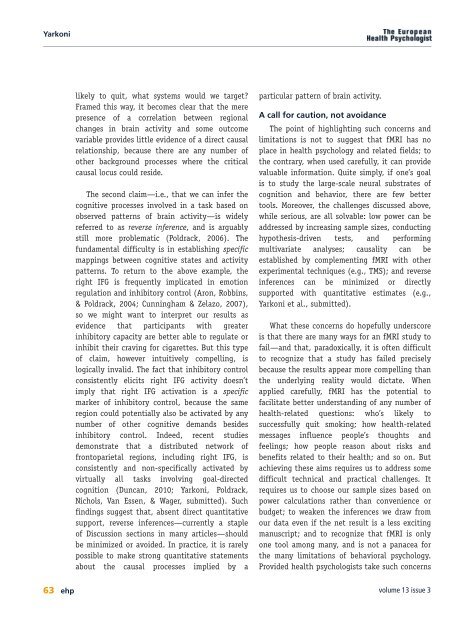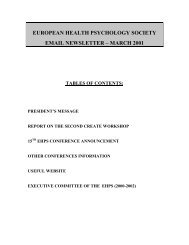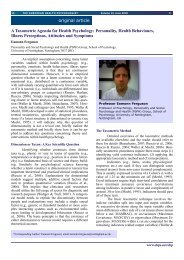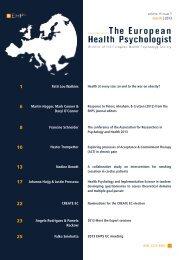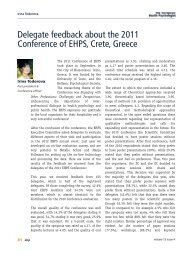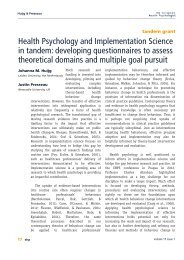PDF download entire issue - European Health Psychology Society
PDF download entire issue - European Health Psychology Society
PDF download entire issue - European Health Psychology Society
You also want an ePaper? Increase the reach of your titles
YUMPU automatically turns print PDFs into web optimized ePapers that Google loves.
Yarkoni<br />
likely to quit, what systems would we target?<br />
Framed this way, it becomes clear that the mere<br />
presence of a correlation between regional<br />
changes in brain activity and some outcome<br />
variable provides little evidence of a direct causal<br />
relationship, because there are any number of<br />
other background processes where the critical<br />
causal locus could reside.<br />
The second claim—i.e., that we can infer the<br />
cognitive processes involved in a task based on<br />
observed patterns of brain activity—is widely<br />
referred to as reverse inference, and is arguably<br />
still more problematic (Poldrack, 2006). The<br />
fundamental difficulty is in establishing specific<br />
mappings between cognitive states and activity<br />
patterns. To return to the above example, the<br />
right IFG is frequently implicated in emotion<br />
regulation and inhibitory control (Aron, Robbins,<br />
& Poldrack, 2004; Cunningham & Zelazo, 2007),<br />
so we might want to interpret our results as<br />
evidence that participants with greater<br />
inhibitory capacity are better able to regulate or<br />
inhibit their craving for cigarettes. But this type<br />
of claim, however intuitively compelling, is<br />
logically invalid. The fact that inhibitory control<br />
consistently elicits right IFG activity doesn’t<br />
imply that right IFG activation is a specific<br />
marker of inhibitory control, because the same<br />
region could potentially also be activated by any<br />
number of other cognitive demands besides<br />
inhibitory control. Indeed, recent studies<br />
demonstrate that a distributed network of<br />
frontoparietal regions, including right IFG, is<br />
consistently and non-specifically activated by<br />
virtually all tasks involving goal-directed<br />
cognition (Duncan, 2010; Yarkoni, Poldrack,<br />
Nichols, Van Essen, & Wager, submitted). Such<br />
findings suggest that, absent direct quantitative<br />
support, reverse inferences—currently a staple<br />
of Discussion sections in many articles—should<br />
be minimized or avoided. In practice, it is rarely<br />
possible to make strong quantitative statements<br />
about the causal processes implied by a<br />
particular pattern of brain activity.<br />
A call for caution, not avoidance<br />
The point of highlighting such concerns and<br />
limitations is not to suggest that fMRI has no<br />
place in health psychology and related fields; to<br />
the contrary, when used carefully, it can provide<br />
valuable information. Quite simply, if one’s goal<br />
is to study the large-scale neural substrates of<br />
cognition and behavior, there are few better<br />
tools. Moreover, the challenges discussed above,<br />
while serious, are all solvable: low power can be<br />
addressed by increasing sample sizes, conducting<br />
hypothesis-driven tests, and performing<br />
multivariate analyses; causality can be<br />
established by complementing fMRI with other<br />
experimental techniques (e.g., TMS); and reverse<br />
inferences can be minimized or directly<br />
supported with quantitative estimates (e.g.,<br />
Yarkoni et al., submitted).<br />
What these concerns do hopefully underscore<br />
is that there are many ways for an fMRI study to<br />
fail—and that, paradoxically, it is often difficult<br />
to recognize that a study has failed precisely<br />
because the results appear more compelling than<br />
the underlying reality would dictate. When<br />
applied carefully, fMRI has the potential to<br />
facilitate better understanding of any number of<br />
health-related questions: who’s likely to<br />
successfully quit smoking; how health-related<br />
messages influence people’s thoughts and<br />
feelings; how people reason about risks and<br />
benefits related to their health; and so on. But<br />
achieving these aims requires us to address some<br />
difficult technical and practical challenges. It<br />
requires us to choose our sample sizes based on<br />
power calculations rather than convenience or<br />
budget; to weaken the inferences we draw from<br />
our data even if the net result is a less exciting<br />
manuscript; and to recognize that fMRI is only<br />
one tool among many, and is not a panacea for<br />
the many limitations of behavioral psychology.<br />
Provided health psychologists take such concerns<br />
63 ehp volume 13 <strong>issue</strong> 3


